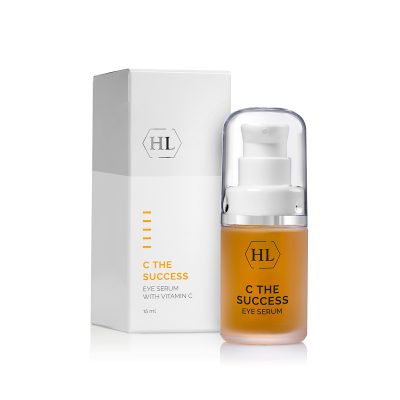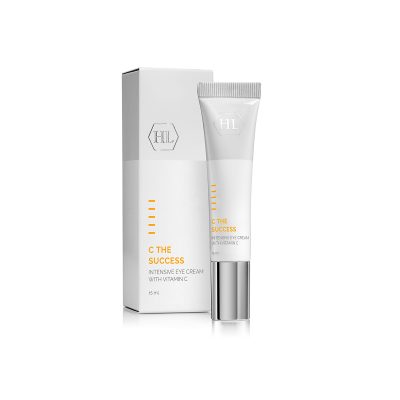Vitamin C Protection for the skin
The beauty industry has been using vitamin C for skin care for many years. This is not surprising, given the vitamin’s key roles in the skin. Over the last decades, vast information has been gathered about the roles it plays in preventing and delaying skin aging and restoring it, within two key mechanisms: aging – the natural aging process of skin; and photoaging – damages resulting from sun exposure. These same roles make Vitamin C a key ingredient for skin care.
Aging
Skin aging is closely related to age-dependent hormonal and biochemical processes that occur in our bodies. A major one is a gradual decline in the production and secretion of estrogen and progesterone – the female sex hormones – leading to a reduction in the amount of subcutaneous fat and water retention capacity, and a decrease in the rate and production of skin cells. Among other things, there is a decrease in the number of fibroblast cells (which produce collagen and elastin) in the dermis. As a result, the production of the two important skin proteins – collagen and elastin – decreases, and at the same time, there is an overdensity of collagen fibers, causing them to lose their shape. In addition, with aging, fibroblast cells produce enzymes that work against the collagen and elastin fibers and damage them.
Vitamin C acts as an effective anti-aging agent both through its functions in collagen synthesis and as a potent anti-inflammatory agent.
Vitamin C and collagen synthesis
Vitamin C is essential for collagen synthesis, and clinical studies have shown that a skin application of vitamin C increases skin collagen production. This is true for both older and younger skin. Furthermore, it turns out that the vitamin affects not only the amount of collagen produced, but also the quality of the collagen molecule. This is because Vitamin C acts as a co-factor for pyrrolysine and lysyl hydroxylase – the enzymes responsible for the stability and cross-linking of collagen molecules. Clinical studies have shown that by applying it on the skin, collagen fibers can be “re-entangled” into older skin. Other studies indicated that the vitamin stimulates fibroblast cell division and boosts migration of those cells into damaged areas that need rehabilitation. In addition, scientists have found that the vitamin can protect the skin by increasing the ability of fibroblasts to repair DNA damage, as well as tumors with mutational potential .
Vitamin C as an anti-inflammatory agent
Many studies have indicated that vitamin C inhibits the formation of the NF Kappa B protein, which is considered to be a major factor in generating inflammatory processes. This protein controls the activity of hundreds of genes involved in inflammatory processes, and is responsible for the activation of several inflammatory cytokines, such as TNF alpha. Therefore, Vitamins C is potentially an anti-inflammatory substance. This is of particular importance since it is now well known that inflammatory processes play a major role in aging, and that many problems that are part of aging are actually caused by them.
Photoaging damages
Exposure to UV radiation is the main cause of increased production of free radicals in the skin. Molecules such as superoxide ion and peroxide can potentially ignite a chain of cascade reactions that damage the skin cells. Their damaging effects occur as a direct result of the chemical changes in the cells’ DNA, cell membranes, and cellular proteins, including collagen.
In addition to the damage caused by the oxidative stress itself to the skin cells, it also appears to indirectly boosts the production of metalloproteinase (MMPs) enzymes in the skin matrix – the intercellular texture. Overproduction of this group of enzymes, whose role in matrix biology has been extensively researched in recent years, leads to the breakdown of collagen. In addition, the oxidative stress also accelerates the production of NF Kappa B – the inflammatory protein. Moreover, the free radicals damage the elastin fibers formed in the skin fibroblasts, and current research has shown that this damage may explain the changes in skin elasticity due to photoaging.
Vitamin C is one of the major substances that counteract photoaging damages, and it has various mechanisms to achieve this. The two most prominent mechanisms are its functions as an antioxidant and as a potent anti-inflammatory agent.
Vitamin C as an antioxidant
Clinical studies examining the effectiveness of Vitamin C against sunlight have shown that this antioxidant is equally effective against UVB (290-320 nm) and UVA (320-400 nm). It protects from UV radiation by neutralizing the free radicals. Vitamin C application at a 10% concentration has been shown to significantly reduce skin redness as a result of UVB radiation, as well as reducing cellular burns by 40%-60%.
Vitamin C is considered not only one of the most potent natural antioxidants, but also the most abundant one in our skin. It is part of a group of enzymatic and non-enzymatic antioxidants that work together to protect the skin from free radicals, which result from the exposure of the skin to a variety of harmful environmental factors.
Being water soluble, vitamin C works in the aqueous areas of the skin cells. It protects it from oxidative stress – a condition whereby cells cannot handle the amount of free radicals – by providing electrons to neutralize these destructive molecules. The vitamin’s very important advantage as an antioxidant is that even its oxidized forms – when their activity has ended against free radicals – are not reactive, so they are not harmful to the skin. In addition, it turns out that sun exposure reduces the amounts of vitamin C in the skin, so it is essential to apply it in order to counteract the free radicals.
Vitamin C and skin whitening
Another major role played by vitamin C in the fight against sun damage is in its whiting of the skin. This function results from its great effectivity as a powerful antioxidant. Studies have shown that it inhibits the oxidation phase in melanin formation. In addition, vitamin C was found to interact with copper ions and active tyrosinase sites, blocking the activity of the tyrosinase enzyme. Tyrosinase is responsible for the first stages in producing the dark melanin pigment, which determines the color of the skin, hair and retina, and protects us from the sun’s ultraviolet radiation. When exposed to the sun, tyrosinase accelerates melanin production in melanocyte cells to protect the skin, resulting in darker skin. The problem is that the pigment particles are not uniformly dispersed, and they sometimes accumulate in a certain area, creating skin spots or hyperpigmentation areas. As the exposure to the sun is more prolonged and accumulative, the spots and hyperpigmentation areas increase and become more severe, prominent and permanent. Interestingly, the vitamin’s most powerful effect is reached through applying it to the skin. In an article published in Plastic and Reconstructive Surgery, researchers summed up its effectiveness in the skin, explaining that: “applying the vitamin to the skin “augments the skin’s ability to neutralize reactive oxygen singles (free-radical damage) that are created by the ultraviolet radiation, thereby preventing photodamage to the skin.”
“C The Success” series
This unique HL Lab series is designed to slow down the aging process, and to repair and restore skin damage and early aging signs resulting from processes connected to aging and to accumulative sun exposure. The products in this series contain an active combination of Vitamin C, tangerine oil and hamamelis. They act to inhibit skin aging processes, reduce depth of wrinkles and fine lines and achieve smoother, suppler, and lighter, even-toned skin. This combination of components reduces skin damage caused by the free radicals found in UV radiation and other environmentally damaging agents, while at the same time accelerating the production and proper reorganization of collagen and elastin, and restoring other natural mechanisms responsible for the repair and healing of the skin. Thus, they help reducing the depth of wrinkles and fine lines, soothing the skin, whitening and improving skin tone, texture and appearance. The result: reduced depth of wrinkles and fine lines and continuous improvement in their appearance; improved skin elasticity and softness; lighter and more even skin tone; whitened sunspots and age spots.
Vitamin C derivatives
Vitamin C has several derivatives, some of which are used in the cosmetics industry:
Ascorbic acid – the natural vitamin C derivative found in fruits and vegetables. The source for its name is the substance discovered by Hungarian biochemist Szent-Györgyi in paprika peppers. Györgyi and the British chemist Hawoth, who first identified and synthesized it in 1933, proposed the name a-scorbic acid – that is, scurvy (tetanus) antacid. Ascorbic acid is also the derivative with the most effective skin absorption. In fact, it is found to be absorbed in the deeper skin layer about 20-40 times more than when it is ingested. However, the disadvantage of ascorbic acid is that its molecule is unstable and easily oxidizes in the presence of air, light or heat. Moreover, when oxidized, ascorbic acid is not only ineffective against free radicals, but, in fact, boosts their production, thus leading to damage to essential molecules in the skin. Also, at least a 10% concentration of ascorbic acid in the preparation is required in order to deliver a sufficient amount of vitamin C to the cells.
Magnesium ascorbyl phosphate – this derivative is more stable than ascorbic acid and is also efficient in boosting collagen production. It can also be used on sensitive skin as it does not irritate it. Its common concentration in cosmetic preparations is 3%-5%.
Ascorbyl Palmitate – this is a fat-soluble form of vitamin C, so it helps protect the skin from lipid oxidation as well. Ascorbyl palmitate is an alternative to ascorbic acid for people with sensitive skin as the substance does not irritate it. It is also more stable than ascorbic acid but less effective than the other derivatives. The optimal concentration of the substance has not been defined yet.
Ascorbyl tetraisopalmitate – another vitamin C derivative that is likely a fat-soluble antioxidant, and is considered to have a better effect than ascorbyl palmitate in stimulating collagen production. It was also found to whiten the skin by suppressing melanin production. The common concentration in preparations is 1% -2%.

-

C The Success Concentrated Vitamin C Serum 30ml
109,88 € Add to cart -
Sale!

C THE SUCCES ANTI AGING KIT (new) SERUM, INTENSIVE DAY CREAM, CREAM
187,05 €Original price was: 187,05 €.140,29 €Current price is: 140,29 €. Read more -
Sale!

C THE SUCCESS EYE SERUM 15ml
92,49 €Original price was: 92,49 €.55,49 €Current price is: 55,49 €. Add to cart -
Sale!

C THE SUCCESS EYE CREAM 15ml in tube
51,74 €Original price was: 51,74 €.38,81 €Current price is: 38,81 €. Add to cart